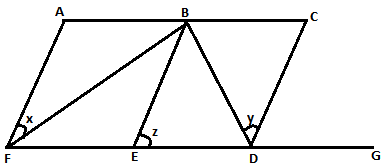5th Grade > Mathematics
INTRODUCTION TO NUMBERS MCQs
:
A
The place value and the face value of a digit in a number are always equal at the ones/units place.
For example in 987,
H T O
9 8 7
The face value of 8 = 8
The place value of 8 = 80
The face vlaue of 9 = 9
The place value of 9 = 900
But, The face vlaue of 7 = 7
The place value of 7 = 7
:
C
The product of largest 3 digit number and 4 digit number 999×9999=9989001
So the product of any three-digit number and a four-digit number cannot have more than 7 digits.
:
B
For the set of Roman numerals X, XI the values are:
X = 10
XI = 11
10 < 11.
So, they are not arranged in descending order.
For the set of Roman numerals XLV, XXII, LI, XI:
XLV = 45 and LI = 51.
45 < 51.
Therefore the set of Roman numerals XLV, XXII, LI, XI are not arranged in descending order.
For the set of Roman numerals XXXVIII, XLIX, LII, LXIV:
LII = 52 and LXIV = 64.
52 < 64
Therefore the set of Roman numerals XXXVIII, XLIX, LII, LXIV are not in descending order.
For the set of Roman numerals LXI, XLIV, XXXVIII, XXV the values are:
LXI = 50 + 10 + 1 = 61
XLIV = 40 + 4 = 44
XXXVIII = 10 + 10 + 10 + 5 + 3 =38
XXV = 10 + 10 + 5 = 25
Since, 61, 44, 38, 25 are in descending order so LXI, XLIV, XXXVIII, XXV are arranged in descending order.
:
C
V, L, D are never repeated in the Roman numeral system.
For example,
We write 102 as 'CII'. We can't write it as 'LLII'.
:
B
The largest 2 digit number = 99
To find the successor of a number, we add 1 to it.
99 + 1 = 100
The successor of 99 = 100
To find the predecessor of a number we subtract 1 from the given number.
99 - 1 = 98
Predecessor of 99 = 98
∴ Product = 98×100=9800
:
A
198 can be written as :
198 = 100+90+8
100 = C
90 = 100-10
90= XC
8 = VIII
∴ 198 = CXCVIII
:
B
To find the smallest number we first arrange the given digits in ascending order.
0 < 1 < 4 < 6 < 7
Since we cannot write a number starting with '0' we have to write it in 2nd position.
So our required order will be 1, 0, 4, 6, 7.
We have to make the smallest 7 digit number using the given digits, so we need 2 more digits.
To make the smallest 7 digit number we will use 1, which is the 2nd smallest digit (∵ we have to make the number without repeating 0).
So the smallest 7 digit number using the digits 4, 0, 1, 7, 6 without repeating 0 is 1011467.
:
D
To round off a number to the nearest 100 we check the last two digits of the number.
If this number is 50 or more, we round up the number to the higher value (nearest higher multiple of 100).
If this number is less than 50, we round down the number to the lower value.( nearest lower multiple of 100)
For 677, 70 > 50. So it is rounded off to 700.
For 833, 30 < 50. So it is rounded off to 800.
So, the given numbers are rounded to 700 and 800.
∴ Product = 700×800
= 560000
:
A
XL = 50 - 10 = 40
(∵ If a symbol of smaller value is written to the left of a symbol of greater value, then its value is subtracted from the symbol of greater value.)
XLI = 40 + 1 = 41
(∵ If a symbol of smaller value is written to the right of a symbol of greater value, then its value gets added to the symbol of greater value.)
XII = 12
∴ XLI + XII = 41 + 12 = 53
:
B
The sum of smallest 2 two-digit numbers = 10 + 10 = 20
And the sum of largest 2 digit numbers = 99 + 99 = 198
So, the sum of all the two-digit numbers will be between 20 and 198.
164 lies in between 20 and 198. So the sum that can be obtained is only 164.
18, 199, 285 do not lie between 20 and 198, so they can not be the sum of 2 two-digit numbers.
















